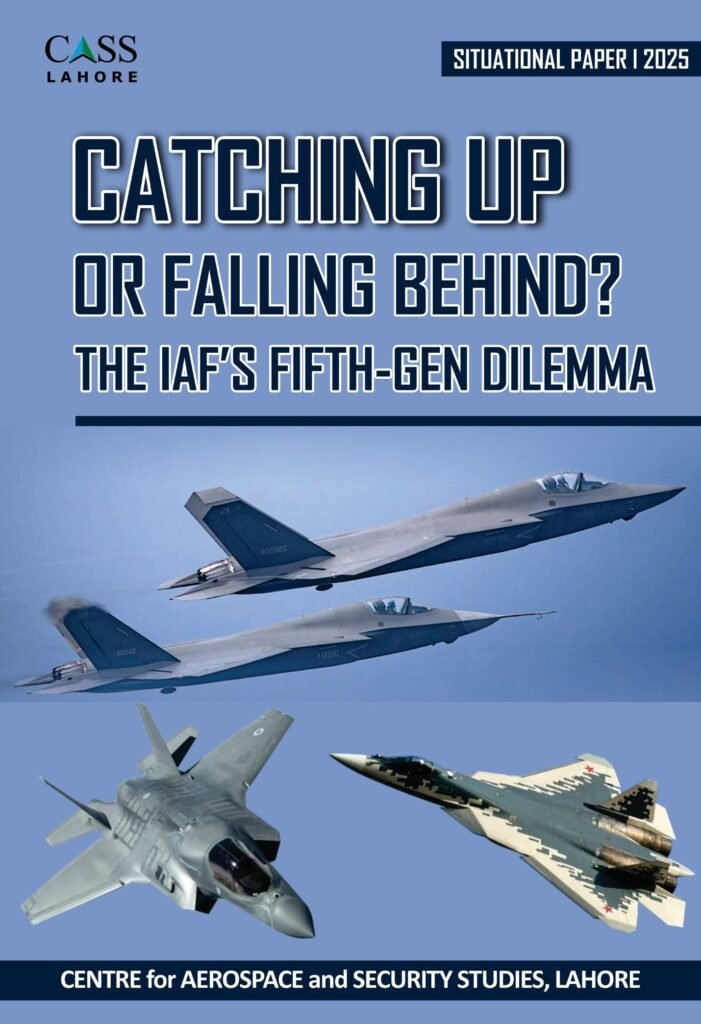
Situational Paper
CATCHING UP OR FALLING BEHIND? THE IAF’S FIFTH-GEN DILEMMA
SEPTEMBER 2025
ABSTRACT
India has long been an aspirant of becoming a regional hegemon and enjoying the superpower status. This desire is, however, undermined by multiple factors relating to India’s capabilities and the vulnerabilities of its air force. This paper argues that despite mighty ambitions, the Indian Air Force (IAF) faces critical technological and strategic disadvantages compared to its regional competitors. The study asserts that the Pakistan Air Force (PAF) has historically maintained a technologically superior fleet to make up for the quantitative lag with the IAF. Continuing this trend, the PAF is all set to induct the fifth-generation stealth J-35 Gyrfalcon. Meanwhile, China’s surprising advancements in next-generation aerial warfare have widened the capability gap with the IAF. This study describes how the IAF has been left behind in the race for modernisation, and analyses various options and troubled pathways for the IAF to acquire fifth-generation fighter jets. It concludes that under the most idealistic scenarios, it would take the IAF seven to eight years to induct the next generation jets, leaving India vulnerable to its competitors, shattering its grand hegemonic ambitions.
Keywords: IAF, PAF, PLAAF, Air Superiority, Regional Hegemony, Fifth-Generation Aircraft, Vulnerabilities, Two-Front War Doctrine
KEY TAKEAWAYS
India’s Hegemonic Aspirations & Air Force Vulnerabilities
Despite its regional ambitions, the IAF remains a critical weakness in India’s strategic calculus due to persistent technological shortcomings. Delays in modernisation undermine its two-front war strategy and aspirations for dominance in the Indian Ocean.
Pakistan and China’s Technological Edge
Pakistan’s planned acquisition of the J-35 and China’s J-20 superiority—along with the maiden flight of its sixth generation fighter—widen the airpower gap, further diminishing India’s competitive edge.
Challenges in IAF Modernisation
The inability of the Hindustan Aeronautics Limited (HAL) to deliver for India’s air power ambitions such as the AMCA, Tejas Mk1A, and Mk2 projects, coupled with the ageing fleet, continue to hinder India’s air superiority ambitions.
Limits of Foreign Procurement
Options such as the F-35 and Su-57 face significant challenges related to cost, supply chain constraints, and customisation issues. Additionally, bureaucratic and political hurdles further complicate India’s ability to enhance its air
combat capabilities.
Geopolitical Stakes of the F-35 Offer
The US aims to integrate India into its Indo-Pacific strategy and counter Russia’s defence influence by offering the F-35. This move aligns with Washington’s broader geopolitical objectives but presents a strategic dilemma for New Delhi.
Geo-economic Constraints
The high cost of the F-35 and the absence of technology transfer conflict with India’s self-reliance goals and HAL’s long-term plans. Moreover, the offer is designed to tilt the Indo-US trade balance in America’s favour while strengthening its military industrial complex.
Operational & Strategic Risks of the F-35
Integrating the F-35 into the existing IAF fleet would require substantial restructuring. Furthermore, India’s possession of the Russian S-400 missile defence system complicates operational compatibility and strategic decision-making.
Regional Security Implications
Even if the F-35 deal materialises, achieving initial operational capability would take seven to ten years, leaving the IAF at a technological disadvantage of five to seven years compared to the PAF.
IAF as India’s Achilles’ Heel
Without urgent and substantial upgrades, the IAF’s technological lag will persist, reinforcing a historical trend of undercutting India’s ambitions for regional influence.
Author(s)


Ameer Abdullah Khan
Senior Research Associate
Azhar Zeeshan
Research Assistant
CASS LAhore

The Centre for Aerospace & Security Studies (CASS) was established in July 2021 to inform policymakers and the public about issues related to aerospace and security from an independent, non-partisan and future-centric analytical lens.


